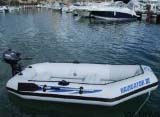The Use of a Yacht's Dinghy
Dinghy safety
The most dangerous time in yachting is when using a dinghy especially an inflatable one, even in an apparently safe harbour there may be a current running and exit from the water almost impossible.
When using the dinghy;
- Always wear a lifejacket

- Use a boarding ladder if one is available
- Take a torch if it could be dark for the return
- Take the pump (if the temperature drops the dinghy will become soft)
- Take the oars when using an outboard motor
- Check the fuel level before you cast off
- If landing in an exposed area, take a small anchor (or perhaps a really big one!)
- Consider taking a VHF radio
- Do not overload the dinghy, and load it evenly (you can not fit more people in after you have been to the pub, than fitted in on the trip ashore!)
- Leave a light on the yacht if you may return after dark (how will you find your yacht)
Boarding the dinghy
Getting into and out of a dinghy from a yacht can be very tricky, particularly if you are not agile or the sea state is a bit bumpy.
Many modern yachts have a "sugar scoop" stern designed for easy access to the dinghy or for swimming, if you have this arrangement or a boarding ladder on the transom this is usually the best place to board the dinghy.

Because it is easy for the dinghy to move when you step in or out, I recommend mooring the dinghy across the stern of the boat, so that both the stern and the bow of the dinghy are firmly tied to the yacht. Then is someone slips they will probably fall back in to the dinghy rather than the water.
If you tie the dinghy alongside the yacht, the same principle applies, firmly tie both ends of the dinghy to the yacht so there is no chance of it suddenly moving. It may be prudent to make sure the crew are clipped the the yacht or dinghy when boarding or disembarking in some conditions.
Landing
Landing on a beach with even a very slight sea running is very difficult to accomplish without getting wet. It is best to be prepared to hop over the side when the water is about knee deep then hold the bow of the dinghy to the waves until everyone has disembarked. The other approach is to move the weight slightly aft then run up the beach at speed (lift the outboard to protect the prop!), the person at the front then jumps out and pulls the dinghy up as far as possible.
Which ever method you use, make sure you are not caught between the dinghy and the beach if it is pushed in by a wave.
If you are arriving in a tidal area, allow for the rise of the tide. In the Channel Islands and Brittany where the range of the tide can be 10m this can mean carrying the dinghy a considerable distance.
I remember being very amused by the antics of my crew who ignored my warning when they rowed ashore at Roscoff in Brittany. They moored the dinghy at the bottom of the steps, when they returned the end of the painter was 4m under water!
Save money ordering your dinghy online.
Sailtrain.co.uk is free to use, but if you feel you would like to contribute to the running and development costs you can donate via Paypal:
Additional Resources:

